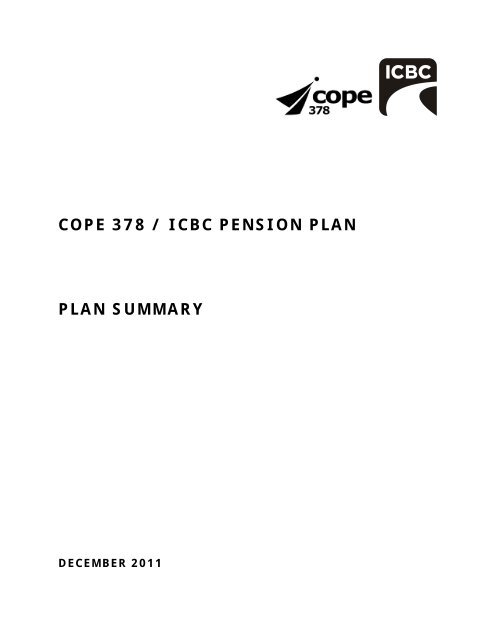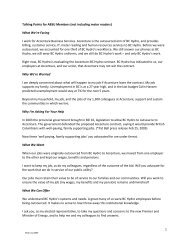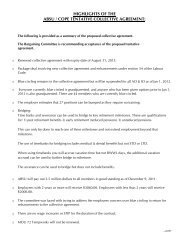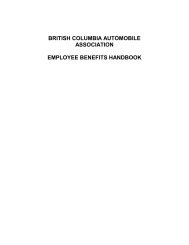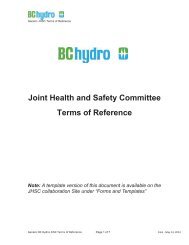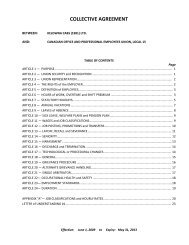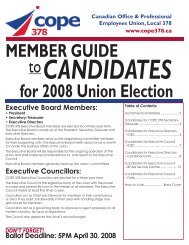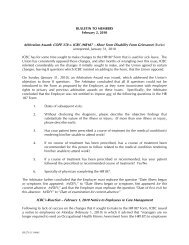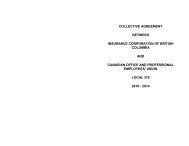ICBC PENSION PLAN FOR MANAGEMENT AND ... - COPE 378
ICBC PENSION PLAN FOR MANAGEMENT AND ... - COPE 378
ICBC PENSION PLAN FOR MANAGEMENT AND ... - COPE 378
You also want an ePaper? Increase the reach of your titles
YUMPU automatically turns print PDFs into web optimized ePapers that Google loves.
<strong>COPE</strong> <strong>378</strong> / <strong>ICBC</strong> <strong>PENSION</strong> <strong>PLAN</strong><br />
<strong>PLAN</strong> SUMMARY<br />
DECEMBER 2011
Contents<br />
Introduction ......................................................................................... 3<br />
Your Pension Plan ................................................................................. 4<br />
Accessing More Information about the Plan .............................................. 5<br />
Membership ......................................................................................... 6<br />
When do I enrol in the Plan? ..................................................................................................................... 6<br />
Can I transfer service or credits from another pension plan? .................................................................. 6<br />
What happens to any prior service I had with this Plan? .......................................................................... 6<br />
Contributions ....................................................................................... 7<br />
Service ................................................................................................ 8<br />
What is pensionable service? .................................................................................................................... 8<br />
Retirement .......................................................................................... 9<br />
What can I do to prepare for retirement? ................................................................................................ 9<br />
When can I retire? ..................................................................................................................................... 9<br />
Early Retirement Date ............................................................................................................................... 9<br />
What if I continue to work past age 65? ................................................................................................... 9<br />
What if I return to work after I retire? ...................................................................................................... 9<br />
When is my pension paid? ........................................................................................................................ 9<br />
Your Pension and the CPP ....................................................................................................................... 10<br />
Retirement at Age 65 or Later ................................................................................................................. 10<br />
How is my pension benefit calculated? ................................................................................................... 10<br />
Early Retirement Pension ..................................................................... 11<br />
How does the bridge benefit work? ........................................................................................................ 11<br />
Early Retirement Reductions ................................................................................................................... 11<br />
Unreduced early retirement pension .................................................................................................................. 11<br />
Reduced early retirement pension ...................................................................................................................... 11<br />
Inflation Protection ............................................................................. 13<br />
How is my pension protected against inflation? ..................................................................................... 13<br />
Disability Benefits ............................................................................... 14<br />
1
What if I become disabled? ..................................................................................................................... 14<br />
Leaving Employment ........................................................................... 15<br />
What are my options? ............................................................................................................................. 15<br />
When does my pension benefit become ‘locked-in’?............................................................................. 15<br />
Transfer to Management ..................................................................... 16<br />
Survivor Benefits ................................................................................ 17<br />
What happens if I die before retirement? .............................................................................................. 17<br />
What happens if I die after retirement? ................................................................................................. 17<br />
Your Pension Plan and Tax ................................................................... 19<br />
Your contributions to the Plan ................................................................................................................ 19<br />
Does membership in the Plan affect my RRSP contribution room? ....................................................... 19<br />
Division of Pension Benefits on Marriage Breakdown ............................... 20<br />
Non-Assignability and Non-Commutability of Benefits .............................. 21<br />
Glossary ............................................................................................ 22<br />
Contact Information ............................................................................ 23<br />
2
Introduction<br />
The <strong>COPE</strong> <strong>378</strong> / <strong>ICBC</strong> Pension Plan (the “Plan”) is a jointly trusteed defined benefit pension<br />
plan. It is governed by the joint trust agreement and Agreement in Principle signed in 2001<br />
by the Plan partners, <strong>COPE</strong> Local <strong>378</strong> and <strong>ICBC</strong>. As a negotiated cost pension plan, the Plan<br />
partners must agree on the contributions to be made to the Plan. The Plan partners are<br />
also responsible for appointing the Plan’s board of trustees.<br />
The board of trustees is responsible for managing the Plan. The trustees may change Plan<br />
rules if they are directed to do so by the Plan partners. The board of trustees is responsible<br />
for the interpretation of the Plan provisions and administration of the Plan terms.<br />
Board of Trustees<br />
The appointees as of December 2011 are:<br />
Bruce Farmer<br />
Alison Gould<br />
Phil Leong<br />
Lori Mayhew<br />
Yasmin Carroll<br />
Jeff Gillies<br />
Phil Headley<br />
Susan Lucas<br />
Len Posyniak<br />
John Gilfoyle (independent chair)<br />
The purpose of the Plan is to provide lifetime retirement income for the members of the Plan<br />
at a reasonable cost.<br />
This handbook is a summary of the Plan. The information in this handbook provides a<br />
summary of the terms of the Plan at the time of publication. From time to time the Plan<br />
text may be amended by <strong>COPE</strong> Local <strong>378</strong> and <strong>ICBC</strong>. If there is any discrepancy between<br />
this information and the Plan text, the Plan text will govern.<br />
Benefits payable from the Plan cannot be assigned.<br />
3
Your Pension Plan<br />
The <strong>COPE</strong> <strong>378</strong> / <strong>ICBC</strong> Pension Plan is a jointly trusteed defined benefit pension plan funded<br />
by contributions made by Plan members and <strong>ICBC</strong>, and investment earnings of the Plan.<br />
The Plan provides:<br />
• a guaranteed stream of income for life based on your earnings and years of Plan<br />
membership<br />
• protection against inflation<br />
• survivor benefits<br />
• a contribution waiver during periods of disability<br />
• early retirement options<br />
• a ‘bridge’ benefit when you retire (payable until you reach age 65)<br />
• options on termination of employment<br />
The Plan pays a monthly pension based on a formula. The formula takes into account your<br />
years of service and your earnings.<br />
Plan members and <strong>ICBC</strong> equally share the cost of the Plan. <strong>ICBC</strong> provides certain<br />
administrative services to the Plan at no cost.<br />
4
Accessing More Information about the Plan<br />
Internet:<br />
View your pension information online, including your annual member statement, and use<br />
the calculators in My Tools to obtain estimates of your retirement income.<br />
Visit the <strong>ICBC</strong> Pension Centre at https://www.tractusweb.com/memberportal/<strong>ICBC</strong>/login.tpz<br />
You will need your <strong>ICBC</strong> employee ID to register with the site and access your account.<br />
Phone:<br />
Obtain assistance with accessing the website, or ask questions about your estimates or<br />
account.<br />
Call the <strong>ICBC</strong> Pension Service Centre at 1-866-598-5614. They are available Monday to<br />
Friday from 8:00 a.m. to 5:00 p.m.<br />
For information about other benefit programs at <strong>ICBC</strong>, contact Employee Benefits at 604-<br />
982-2702 or 604-982-6011.<br />
Mail:<br />
<strong>ICBC</strong> Pension Service Centre<br />
Suite 900, 550 Burrard Street<br />
Vancouver, BC V6C 3S8<br />
5
Membership<br />
When do I enrol in the Plan?<br />
You have the option to enrol on the first of the month coincident with or next following your<br />
date of hire while a member of <strong>COPE</strong> Local <strong>378</strong>. If you elect not to enrol immediately, you<br />
may enrol on the first of any month prior to completing two years of consecutive<br />
employment service. After completing two years of consecutive employment service, you<br />
will automatically be enrolled in the Plan.<br />
Once you become a member of the Plan you remain a member until you terminate your<br />
employment or retire from <strong>ICBC</strong> or are no longer a member of <strong>COPE</strong> Local <strong>378</strong>.<br />
If you were a member of the <strong>ICBC</strong> Pension Plan for Management & Confidential Employees<br />
(the “Management Plan”) and are hired into a <strong>COPE</strong> Local <strong>378</strong> position at <strong>ICBC</strong>, you will<br />
automatically be enrolled in this Plan.<br />
Can I transfer service or credits from another pension plan?<br />
No, currently you cannot transfer service or credits from another pension plan. If you move<br />
from a Management Group position at <strong>ICBC</strong> to a <strong>COPE</strong> Local <strong>378</strong> position, your pension<br />
benefit will not transfer to this Plan but you will retain your benefit under the Management<br />
Plan.<br />
What happens to any prior service I had with this Plan?<br />
If you previously participated in this Plan and have not started your benefit as a retirement<br />
income or transferred the value out of the Plan, your pensionable service will be combined<br />
to provide one pension benefit.<br />
6
Contributions<br />
You and <strong>ICBC</strong> contribute to the Plan. Your contributions are based on eligible pensionable<br />
earnings.<br />
Eligible pensionable earnings include:<br />
• regular base pay<br />
• eligible shift premiums (afternoon, evening, weekend)<br />
• extended hours premiums<br />
Excluded from pensionable earnings are:<br />
• overtime<br />
• gainsharing payments<br />
• vacation payouts<br />
• any other allowances<br />
Employee and <strong>ICBC</strong> contribution rates for 2012<br />
7.74% On earnings up to the YMPE of $50,100<br />
10.32% On earnings above the YMPE of $50,100<br />
Both you and <strong>ICBC</strong> pay lower contributions on earnings up to the year’s maximum<br />
pensionable earnings (YMPE) and higher contributions on earnings over the YMPE. The<br />
YMPE is also the Canada Pension Plan (“CPP”) earnings limit – you and <strong>ICBC</strong> make CPP<br />
contributions on earnings up to this limit. The <strong>COPE</strong> Plan contribution rate is lower for<br />
earnings up to this limit because CPP and the <strong>COPE</strong> Plan are designed to work together to<br />
provide a combined pension benefit at an affordable cost.<br />
Contribution rates may fluctuate from year to year based on the Plan’s financial position and<br />
funding requirements. A valuation is performed at least once every three years to assess<br />
and establish contribution requirements.<br />
The contributions made by employees and <strong>ICBC</strong> help fund the pensions paid by the Plan.<br />
The benefit you receive from the Plan is based on your earnings and service.<br />
7
Service<br />
What is pensionable service?<br />
Pensionable service is the number of years and months you were making contributions to<br />
the Plan. Your total pensionable service is used to calculate your pension benefit on<br />
termination, death or retirement.<br />
Pensionable service includes periods of time for which:<br />
• you contributed to the Plan and have not had a refund of contributions<br />
• you earned pension while on an approved disability plan<br />
You accrue pensionable service for each day that you contribute to the Plan.<br />
You cannot purchase pensionable service for periods of employment when you were not a<br />
member of the Plan or did not make contributions. You also cannot transfer service from<br />
another pension plan.<br />
8
Retirement<br />
What can I do to prepare for retirement?<br />
• Visit https://www.tractusweb.com/memberportal/<strong>ICBC</strong>/login.tpz for information on<br />
retirement planning to help you prepare for life after work.<br />
• If you have registered with the <strong>ICBC</strong> Pension Centre website above, try the pension<br />
calculator tools under My Tools to obtain an estimate of your pension income and<br />
options.<br />
• Visit http://www.servicecanada.gc.ca/eng/isp/common/cricinfo.shtml for information on<br />
the government benefits available.<br />
When can I retire?<br />
The normal retirement date from the Plan is the first of the month following the month in<br />
which you attain at age 65. Many Plan members may wish to retire prior to that date.<br />
Early Retirement Date<br />
You can retire any time once you reach age 55. This means you can begin receiving your<br />
pension benefit from the Plan as early as age 55 regardless of how much pensionable<br />
service you have.<br />
What if I continue to work past age 65?<br />
If you continue to work past age 65 without a break in service, your active membership in<br />
the Plan will continue. However you must start receiving your pension no later than<br />
December 1 st of the year in which you attain age 71. At that time your pension will<br />
commence whether or not you are still working and you will no longer make contributions to<br />
the Plan.<br />
What if I return to work after I retire?<br />
Some Plan members return to work after they have commenced receiving their pension<br />
from the Plan.<br />
If you return to work you will have the option of either re-enrolling in the Plan and<br />
suspending your monthly pension benefit, or waiving your option to enrol in the Plan and<br />
continuing to receive your monthly pension benefit.<br />
If you re-enrol in the Plan you will make contributions and be credited with pensionable<br />
service until the earlier of the following:<br />
• November 30 th in the year in which you attain age 71; or<br />
• the day on which you subsequently retire.<br />
When you subsequently retire, your pensionable service and earnings will be combined to<br />
recalculate your pension benefit.<br />
When is my pension paid?<br />
The pension benefit you receive is paid monthly on the last banking day of the month.<br />
9
Your Pension and the CPP<br />
Your pension is designed to work with the Canada Pension Plan (“CPP”) to provide you with<br />
stable, combined retirement income at a reasonable cost.<br />
While you work, you pay lower contribution rates on the portion of your earnings up to the<br />
earnings on which you contribute to the CPP. This reduces the combined cost of your <strong>COPE</strong><br />
Plan and CPP contributions.<br />
When you retire, your <strong>COPE</strong> Plan and CPP pensions provide you with retirement income.<br />
Retirement at Age 65 or Later<br />
The Plan provides a lifetime pension regardless of when you chose to retire.<br />
How is my pension benefit calculated?<br />
Your <strong>COPE</strong> Plan lifetime benefit from age 65 or later is calculated as:<br />
1.3% x<br />
“best five” earnings up<br />
to the YMPE in year<br />
prior to retirement<br />
x<br />
pensionable service<br />
plus<br />
2.0% x<br />
“best five” earnings<br />
above YMPE in year<br />
prior to retirement<br />
x<br />
pensionable service<br />
equals your <strong>COPE</strong> Plan lifetime pension benefit from age 65<br />
based on the normal form (prior to any adjustments for<br />
inflation protection)<br />
“best five” earnings - this is the annual average of 60 months during which your earnings<br />
were at their highest. It does not include any overtime pay, vacation payouts or Gainshare<br />
pay.<br />
Your monthly earnings are calculated by dividing your annual reported pensionable earnings<br />
by your total months of pensionable service in the year.<br />
pensionable service - this is the number of years of service you have credited in the Plan.<br />
YMPE – this is the Year’s Maximum Pensionable Earnings for the calendar year prior to your<br />
year of retirement.<br />
normal form – is a pension payable for your life with a minimum of 5 years (60 months) of<br />
payments. When you die, if you have not received the minimum of 5 years of payments the<br />
remaining minimum payments will continue to your beneficiary. Other options are available<br />
to you on retirement and will provide an actuarially equivalent pension benefit. See What<br />
Happens if I Die After Retirement.<br />
10
Early Retirement Pension<br />
You can retire early from the Plan if you are 55 years of age or older.<br />
If you retire before age 65, you will also receive a bridge benefit payable until age 65.<br />
How does the bridge benefit work?<br />
This temporary benefit supplements your lifetime pension benefit until age 65 when it is<br />
expected that your CPP pension will take over.<br />
The bridge benefit:<br />
• will not necessarily be the same as your CPP benefit;<br />
• continues to be paid to age 65 even if you commence receiving your CPP benefit<br />
early (from age 60)<br />
The bridge benefit is payable to age 65 and is calculated as follows:<br />
0.7% x<br />
“best five” earnings up<br />
to the YMPE in year<br />
prior to retirement<br />
x<br />
pensionable service<br />
Early Retirement Reductions<br />
There are two types of early retirement pensions: unreduced and reduced.<br />
Unreduced early retirement pension<br />
You qualify for an unreduced pension if you retire and:<br />
• you are 60 years of age or older; or<br />
• your age plus total employment service equals at least 85 (“rule of 85”).<br />
An unreduced pension means that your early retirement pension is calculated without a<br />
reduction.<br />
To determine if you are eligible for an unreduced pension, the Plan considers your<br />
employment service since your latest date of hire plus your age at the time you commence<br />
your pension.<br />
Reduced early retirement pension<br />
If you don’t qualify for an unreduced pension you may still retire early (from age 55 on)<br />
with a reduced pension.<br />
In this case the Plan considers how close you are to age 60, your years of employment<br />
service, and the Rule of 85.<br />
If your employment service is 10 years or greater, the early retirement reduction factor is<br />
3% per year (prorated for partial years).<br />
11
If your employment service is less than 10 years, the early retirement reduction factor is<br />
5% per year (prorated for partial years).<br />
The early retirement reduction factor is applied to reflect that it is expected that you will be<br />
receiving the pension benefit for a longer period of time than if you retired at age 60.<br />
Your <strong>COPE</strong> <strong>378</strong> / <strong>ICBC</strong> Pension is reduced by the appropriate early retirement reduction<br />
factor above multiplied by the lesser of:<br />
• 60 minus age at which you retire; or<br />
• 85 minus your current age plus employment service.<br />
The reduction factor is prorated for partial years.<br />
For example:<br />
Age at retirement<br />
Employment<br />
service at<br />
retirement<br />
Points toward<br />
Rule of 85<br />
Reduction<br />
57 24 81 9%<br />
58 8 N/A 10%<br />
55 33 88 0%<br />
12
Inflation Protection<br />
How is my pension protected against inflation?<br />
Every calendar quarter the pensions in payment from the Plan are adjusted to reflect<br />
changes in the average Consumer Price Index. These adjustments reflect only positive<br />
changes; there is no adjustment down if the average CPI decreases over the measurement<br />
period.<br />
Positive percentage adjustments to pensions will be made equal to the percentage<br />
difference between the average CPI for the quarter ending three months prior to the<br />
adjustment date and the average CPI for the quarter ending six months prior to the<br />
adjustment date.<br />
Should there be a decrease in the average CPI at any time, the pension benefit will remain<br />
the same until such time as the average CPI exceeds the previous high at which the last<br />
increase was calculated.<br />
13
Disability Benefits<br />
What if I become disabled?<br />
If you are totally disabled you continue to earn pensionable service without having to make<br />
contributions to the Plan. As well, the Plan will adjust your annual base earnings to reflect<br />
changes in the Consumer Price Index.<br />
This provision continues until:<br />
• you are no longer considered to be totally disabled;<br />
• you elect to receive a termination benefit;<br />
• you return to work other than under a rehabilitation program sponsored by the long<br />
term disability carrier;<br />
• you reach your normal retirement date;<br />
• you retire; or<br />
• you die.<br />
14
Leaving Employment<br />
The reality is that people change jobs during their work life. If you leave <strong>ICBC</strong> prior to<br />
reaching retirement age, the Plan provides options for your future retirement pension.<br />
What are my options?<br />
If you leave employment and are not yet eligible for a retirement pension (i.e. not age 55 or<br />
older), you will receive an information package from the <strong>ICBC</strong> Pension Service Centre that<br />
will outline your options. This may include some or all of the options described below.<br />
1. Keep your pension benefit with the <strong>COPE</strong> Plan as a deferred pension<br />
This gives you a future stream of pension income for life. Your pension benefit is<br />
inflation protected and provides early retirement options and survivor benefits. On<br />
early retirement your benefit is subject to reductions.<br />
If you had more than 10 years of employment service at your date of termination<br />
and were age 50 or greater, the early retirement reduction is 5% for each year that<br />
your pension commences prior to age 60.<br />
If you had less than 10 years of employment service at your date of termination or<br />
were under age 50, the early retirement reduction is 5% for each year that your<br />
pension commences prior to age 65.<br />
2. Transfer your commuted value out of the <strong>COPE</strong> Plan<br />
The commuted value is the estimated lump sum amount your pension is currently<br />
worth today, based on prescribed actuarial assumptions.<br />
You may choose to transfer your commuted value to:<br />
• a locked-in retirement account (LIRA) – this is done through a lump sum<br />
payment to your financial institution;<br />
• an insurance company to purchase an annuity (providing regular income<br />
payments to you upon retirement); or<br />
• another registered pension plan in Canada that can accept the transfer.<br />
In some cases a portion of the commuted value may be required to be received in<br />
cash, less withholding tax.<br />
3. Elect a cash refund (if your benefit is not locked-in)<br />
If your benefit is not locked-in, you may elect a cash refund of your contributions<br />
plus interest. You may also be able to transfer the cash refund to your RRSP.<br />
When does my pension benefit become ‘locked-in’?<br />
Your pension benefit becomes locked-in once you are vested in the Plan. This occurs when<br />
you have 2 years (24 months) of Plan membership (including Management Plan<br />
membership) or 5 years of employment service. Under BC pension law, a pension benefit<br />
that is locked-in must be used to provide retirement income; it cannot be cashed out.<br />
15
Transfer to Management<br />
If you transfer from a <strong>COPE</strong> Local <strong>378</strong> position to a Management position at <strong>ICBC</strong>, you will<br />
automatically be enrolled in the Management Plan and retain your benefit under the <strong>COPE</strong><br />
Plan.<br />
16
Survivor Benefits<br />
In the event of your death, the Plan provides options for survivor benefits for your spouse<br />
or beneficiaries.<br />
When you die, survivor benefits are paid according to provisions of both the Plan and the BC<br />
Pension Benefits Standards Act. Your will cannot change the order shown below, but it does<br />
help us to direct any benefit to your beneficiary or estate, if you do not have a spouse.<br />
What happens if I die before retirement?<br />
Relationship to You<br />
1. your eligible spouse is<br />
first in line for survivor<br />
benefits<br />
2. if you do not have an<br />
eligible spouse, or your<br />
spouse has signed a valid<br />
spousal waiver of preretirement<br />
benefits, your<br />
beneficiary on file with<br />
the Plan will be entitled<br />
to survivor benefits<br />
3. if you have no<br />
beneficiary on file with<br />
the Plan<br />
Type of Benefit<br />
Spousal options are:<br />
• Lump sum payment or transfer to a locked-in<br />
RRSP of an amount equivalent to 100% of the<br />
commuted value of the benefit accrued as of<br />
the date of death<br />
• Immediate spousal pension equivalent to the<br />
lifetime pension accrued as of the date of<br />
death payable for your surviving spouse’s life.<br />
This pension benefit is indexed to inflation.<br />
Your named beneficiary will receive a lump sum<br />
payment (minus income tax) of an amount equivalent<br />
to 100% of the commuted value of the benefit<br />
accrued as of the date of death<br />
Your estate will receive a lump sum payment (minus<br />
income tax) of an amount equivalent to 100% of the<br />
commuted value of the benefit accrued as of the date<br />
of death<br />
What happens if I die after retirement?<br />
When you retire you will be required to select an option for pension payment. Any option<br />
you elect will provide a pension payable to you for life. The option you elect will determine<br />
what payments (if any) may continue following your death. Your pension payments will be<br />
adjusted so that they are actuarially equivalent in value to your pension payable in the<br />
normal form (life guaranteed 60 months). You can go to the <strong>ICBC</strong> Pension Centre website<br />
to estimate the size of your monthly pension under various options.<br />
If you have a spouse when you retire you must elect an option which provides a lifetime<br />
pension to your spouse of at least 60%, unless your spouse elects to waive his or her right.<br />
Pension Option<br />
Life Only<br />
Description<br />
Provides a pension payable for your life. If you die prior to<br />
receiving a total of payments equivalent to your contributions<br />
plus interest, the balance will be paid to your beneficiary.<br />
17
Life Guaranteed<br />
5 Year (60<br />
months)<br />
Normal Form<br />
Life Guaranteed<br />
10 Year (120<br />
months)<br />
Joint and<br />
Survivor Pension<br />
Joint and<br />
Survivor<br />
Reducing to 66%<br />
Joint and<br />
Survivor<br />
Reducing to 60%<br />
Joint and<br />
Survivor<br />
Reducing to 50%<br />
Provides a pension payable for your life. If you die prior to<br />
receiving total of payments equivalent to your contributions plus<br />
interest or at least 60 months of payments, the balance will be<br />
paid to your beneficiary.<br />
Provides a pension payable for your life. If you die prior to<br />
receiving total of payments equivalent to your contributions plus<br />
interest or at least 120 months of payments, the balance will be<br />
paid to your beneficiary.<br />
Provides a pension payable for your life. If you pre-decease your<br />
spouse, your spouse will receive a lifetime pension equivalent to<br />
your pension (without the bridge). If you and your spouse die<br />
prior to receiving a total of payments equivalent to your<br />
contributions plus interest, the balance will be paid to your<br />
beneficiary.<br />
Provides a pension payable for your life. If you pre-decease your<br />
spouse, your spouse will receive a lifetime pension equivalent to<br />
66% of your pension (without the bridge). If you and your<br />
spouse die prior to receiving a total of payments equivalent to<br />
your contributions plus interest, the balance will be paid to your<br />
beneficiary.<br />
Provides a pension payable for your life. If you pre-decease your<br />
spouse, your spouse will receive a lifetime pension equivalent to<br />
60% of your pension (without the bridge). If you and your<br />
spouse die prior to receiving a total of payments equivalent to<br />
your contributions plus interest, the balance will be paid to your<br />
beneficiary.<br />
Provides a pension payable for your life. If you pre-decease your<br />
spouse, your spouse will receive a lifetime pension equivalent to<br />
50% of your pension (without the bridge). If you and your<br />
spouse die prior to receiving a total of payments equivalent to<br />
your contributions plus interest, the balance will be paid to your<br />
beneficiary.<br />
18
Your Pension Plan and Tax<br />
Your contributions to the Plan<br />
Your contributions to the Plan lower your taxable income. <strong>ICBC</strong> reports your contributions<br />
to the Plan to Canada Revenue Agency (CRA) on your T4 slip each year.<br />
Does membership in the Plan affect my RRSP contribution room?<br />
Yes. A pension adjustment (PA) reflects the deemed pension benefit earned you earned in<br />
the year as a member of the Plan. <strong>ICBC</strong> reports this PA to Canada Revenue Agency (CRA)<br />
in box 52 of your T4 slip.<br />
CRA uses your PA in their formula to calculate your new RRSP contribution room for the<br />
current tax year.<br />
18% x<br />
Previous year’s income<br />
(up to a maximum)<br />
-<br />
Previous year’s PA (up to a<br />
maximum)<br />
After you file your tax return, CRA sends you a Notice of Assessment which includes a<br />
statement of your available RRSP contribution room for the year. You may make an RRSP<br />
contribution up to this amount, or carry it forward, within limits, for use in a future year.<br />
19
Division of Pension Benefits on Marriage<br />
Breakdown<br />
Pension benefits are considered an asset during marriage breakdown.<br />
If, in your separation or divorce agreement, you have agreed to divide your pension benefit,<br />
the Plan provides that your former spouse may be designated as a limited member under<br />
the Plan. Upon being designated as a limited member, your former spouse will not be able<br />
to participate in the Plan, but he/she will have a benefit entitlement available to him/her<br />
when you terminate your employment or first become eligible to retire. Your benefit will be<br />
reduced by your former spouse’s entitlement.<br />
There is a charge of $500 for administration costs to set up your former spouse as a limited<br />
member.<br />
If you are entering into discussions about separation or divorce, please ask your legal<br />
counsel about Division of Pension (Part 6) of the Family Relations Act or contact the <strong>ICBC</strong><br />
Pension Service Centre.<br />
20
Non-Assignability and Non-Commutability of<br />
Benefits<br />
In no event shall benefits payable from the Plan confer upon any member, or any other<br />
person, any right or interest which is capable of being surrendered or commuted except as<br />
specifically provided by the Plan.<br />
21
Glossary<br />
“Best Five” Earnings - For years of pensionable service earned prior to 2010, this is the<br />
annual average of 60 months during which your earnings were at their highest. It does not<br />
include any overtime pay, vacation payouts or gainshare pay.<br />
Your monthly earnings are calculated by dividing your annual reported pensionable earnings<br />
by your total months of pensionable service in the year.<br />
Bridge Benefit – A temporary monthly pension benefit payable from the Plan to<br />
supplement retirement income to age 65.<br />
Early Retirement Date – The date when you become eligible to commence your pension<br />
benefit from the Plan regardless of how much service you have. You reach this date when<br />
you are age 55.<br />
Locked-in – Under British Columbia pension law, when your pension benefit is locked-in<br />
you must use it as future retirement income. You cannot cash it out, except in vary rare<br />
cases. Your pension benefit becomes locked-in once you have completed 2 years of Plan<br />
membership.<br />
Maximum Pension – The Income Tax Act limits the amount of pension that can be paid<br />
from a registered pension plan. In 2011, this is $2,552.22 per year of credited service.<br />
Normal Form – is a life pension with a 5 year (60 months) guarantee. Other options are<br />
available to you on retirement and will provide an actuarially equivalent pension benefit.<br />
See What Happens if I Die After Retirement.<br />
Normal Retirement Date – The last day of the month in which you attain age 65.<br />
Pensionable Service – The number of days, months and years you have been a member<br />
of the Plan making contributions, or when you were a Plan member and on an approved<br />
disability claim.<br />
Small Pension Benefit – On retirement, termination or death, if the pension benefit is<br />
sufficiently small based on applicable legislation, the member or surviving spouse may elect<br />
or be required to take a commuted value payout instead of receiving a lifetime pension<br />
benefit.<br />
Spouse – The legal or common-law spouse of the member.<br />
Legal spouse – the person who is legally married to the Plan member and has not<br />
lived apart from the Plan member for more than 2 years<br />
Common-law spouse – the person who has lived together with the Plan member in a<br />
marriage-like relationship continuously for a period of not less than 2 years<br />
Years Maximum Pensionable Earnings – The Canada Pension Plan (CPP) earnings<br />
maximum. In 2012 this maximum is $50,100.<br />
22
Contact Information<br />
Internet:<br />
https://www.tractusweb.com/memberportal/<strong>ICBC</strong>/login.tpz<br />
Phone:<br />
<strong>ICBC</strong> Pension Service Centre<br />
1-866-598-5614<br />
available from 8:00 a.m. to 5:00 p.m.<br />
Mail:<br />
<strong>ICBC</strong> Pension Service Centre<br />
c/o Mercer<br />
Suite 900, 550 Burrard Street<br />
Vancouver, BC V6C 3S8<br />
E-mail:<br />
pension_cope@icbc.com<br />
23


